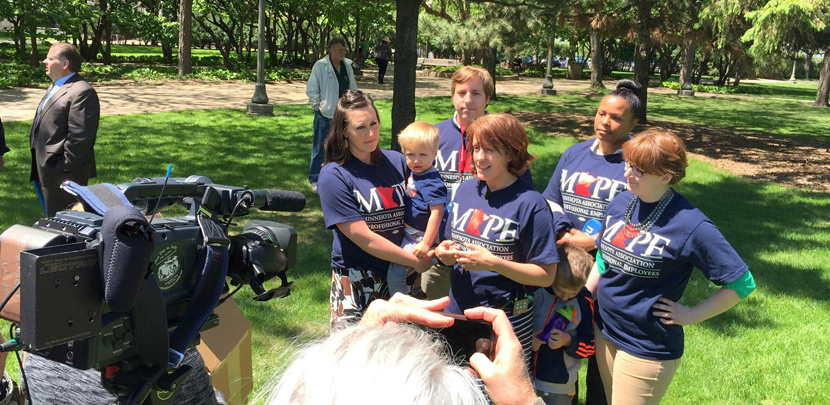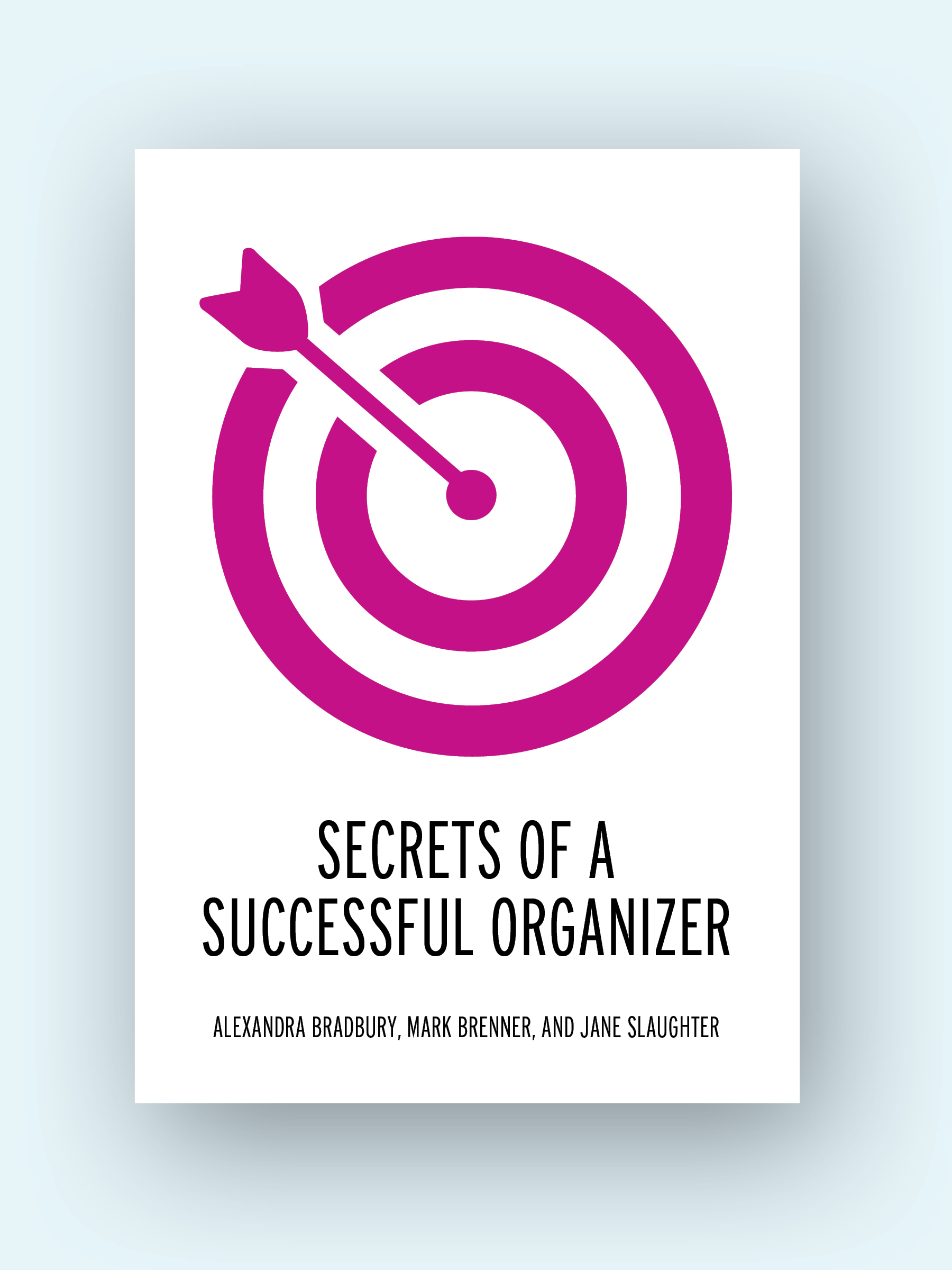Turning an Issue into a Campaign: How Minnesota Public Employees Stood Up for Paid Parental Leave

Minnesota Association of Professional Employees (MAPE) fight and won an issue that mattered to younger members—paid parental leave. Photo: MAPE
Many unions agonize over how to get young workers involved. At the Minnesota Association of Professional Employees (MAPE), we did it with a fight over an issue that mattered to younger members—paid parental leave.
“Three months after we adopted our second son,” wrote a member in one of the stories we gathered over the course of our campaign, “I had to empty all the change jars in our house to make sure we had enough money to pay our monthly mortgage.”
Because this member stood up, future members will not have to go through such an experience.
What Made Paid Parental Leave a Good Organizing Issue?
Organizers are always on the lookout for problems that can be solved through collective activity. Use these four criteria to evaluate a possible organizing issue:
Is it widely felt? Many people must feel that this is a real problem and agree with the solution you’re pursuing. It became clear that paid parental leave was a hot issue among MAPE members when an initial meeting attracted 75 people.
Is it deeply felt? It’s not enough that many people agree if none feels strongly enough to do anything about it. Paid parental leave hit home, touching on the value of family. Enough members were ready to back up their feelings with action to form a Solidarity Team.
Is it winnable? It’s hard to know for sure whether you will win, but it’s possible to get a good idea of whether you can. Identify the decision-maker who can give you what you want. How hard do you expect this person to resist, and how much pressure can your group muster? MAPE had evidence that workers elsewhere had won similar benefits—and a decision-maker, the governor, who seemed moveable.
Does it build the union and build leaders? MAPE had a goal to involve more of its newer members—and this issue mattered especially to them. Through this campaign, many newer members participated in union activities for the first time or took on new roles of leadership.

Read more about what makes a good organizing issue and how to turn it into a campaign in Labor Notes’ newest book, Secrets of a Successful Organizer, available at labornotes.org/secrets.
It started with just a few of us who got angry about the problem, and grew into a two-year campaign that energized our union by attracting new members, boosting meeting participation, and developing new leaders.
And when we won the right to six weeks of paid parental leave for both parents for the birth or adoption of a child, a new generation felt the power of the union.
Our victory benefits not only MAPE’s 14,000 members but all 32,000 union-represented executive-branch employees, including members of AFSCME, Nurses United, and the teachers unions.
PACKED MEETING
It all began in 2014 when a handful of new members from various locals began brainstorming about ways to improve government. One of them, Holly Lahd, brought the lack of paid parental leave back to her colleagues in Region 6, which includes employees in several large state agency buildings in downtown St. Paul. Her local president was looking to add younger members to the statewide negotiating team. So he recruited Lahd, a Department of Commerce worker who was fired up about this issue on behalf of a friend who had recently become a parent.
Lahd hosted a December meeting at work to ask members for input on a “Families First” contract. We expected 15 people. We were shocked when 75 filled the room—our first sign that this was an issue that really mattered to members.
We asked folks to sign “Count Me In” commitment cards agreeing to help do research, talk to other members one on one, or gather personal stories. By following up on the cards with one-on-one conversations, Region 6 recruited a “Solidarity Team” to campaign for paid parental leave.
GETTING PERSONAL
The team gathered information that Lahd could bring to negotiations, including dozens of stories. We started by asking co-workers to share a paragraph about their own experiences around the birth or adoption of their children. Soon this ballooned into gathering stories from across the union.
We heard from a parent who had exhausted her vacation and sick leave when her spouse was critically ill—leaving her no paid time off for the birth of their child.
We heard from parents who had struggled to pay the bills for their newborns’ critical medical needs.
We heard from parents who had adopted children, but weren’t able to take time off to help them adjust to their new families.
Eventually we compiled these stories into a booklet that we distributed to anyone who would listen—including strategic targets like the governor and lieutenant governor, legislators and state agency commissioners. Members also researched how much paid parental leave was guaranteed in other countries and offered by other U.S. employers. We also visited other public employers who were already offering some kind of paid parental leave, like the city of St. Paul, to see what worked, what didn't, and how such a policy could be translated to the state workforce.
FAMILY PHOTOS
In a January “Show Us Your Family” day, 100 members brought photos from home and displayed them on their cubicles to show the importance of family. This seemingly small action started conversations and got more folks involved.

SUPPORT LABOR NOTES
BECOME A MONTHLY DONOR
Give $10 a month or more and get our "Fight the Boss, Build the Union" T-shirt.
On the first day of negotiations in March 2015, the Solidarity Team encouraged members to call the governor’s office, asking him to support a family-friendly contract. A hundred people made the calls.
As word spread, members around the state began to join our campaign. Local leaders brought the issue to their regular meetings and found support. A Region 9 meeting about paid parental leave drew turnout 50 percent higher than its usual meetings.
An ad hoc leadership team took shape, run by member leaders in Regions 6 and 9. Outside of bargaining, we looked for other channels to apply pressure.
The commissioners of state agencies are all appointed by the governor. They see him at cabinet meetings, and many have a rapport with him. So in each agency, MAPE leaders asked their commissioner to meet with us.
We held eight of these meetings, with varying levels of success. Some commissioners agreed to speak with the governor, or to raise the issue in a cabinet meeting. Others agreed only to send an email or discuss it with other commissioners.
We also talked with the lieutenant governor, a woman who had worked with us in the past and who we hoped would see the value of this benefit. She later became an outspoken ally on the issue.
BIGGER AND BIGGER
That June, we held our first action—a rally that drew 250 members along with legislators, commissioners, members of AFSCME, the Minnesota Nurses, and other unions, and municipal officials from two cities that already provided paid parental leave. It was one of the largest gatherings of MAPE members since the union went on strike in 2001. At the rally, the Commissioner of Health, appointed by the governor, spoke in favor of the policy.
Despite all this work, we did not win paid parental leave in our 2015-2017 contract. But the governor agreed to a joint state-union taskforce to explore options for it.
We kept organizing. That October we persuaded the taskforce to meet with MAPE members. We turned out 80 people; members shared their stories and key administrators committed to keep pursuing the issue.
After the meeting, MAPE members stuck around for a strategy session. We knew we needed to expand support in the less-active regions, and among other state unions. We asked each region to keep pushing the agency leaders and to organize three local actions before the New Year. One local sent holiday cards to thank the governor for his support. Another briefed 20 nonunion state employees on the issue.
By early 2016 we were confident we had gained the governor’s support—but our conversations had mostly been between his staff and a few MAPE leaders. It was time to cement his commitment by showing him our numbers firsthand. We decided to turn out 500 state employees to hear about paid parental leave from the governor himself.
GOVERNOR SHOWS UP
The day arrived, a Tuesday afternoon in March. A few of us met early to set up, practice our talking points, and comment how sad it would be if we couldn’t fill all these chairs. But as people began to file in, the temperature rose; excitement grew. Soon it was standing room only. The lieutenant governor, the task force, and key commissioners were in the front row.
Only the governor’s chair was empty. As we kicked off the program worries floated through our heads—What if he doesn’t show up? Will he say what we expect? How did it get so hot in here?
He arrived. Discovering how warm the room was, he removed his coat and tie and made his way to the front row. We knew his schedule was tight, so we interrupted our agenda to introduce him—to deafening applause.
The governor spoke warmly about his own experiences. He remembered coming to work as a new father, completely sleep-deprived, laying his head on his desk and wondering how he could possibly make it through the day. Now he realized he wanted better for state employees—his employees.
Members seemed in awe. The governor is our highest boss; this was the first time many of us had met him in person. After he left to a standing ovation, the lieutenant governor reiterated the commitment. On the spot she promised state employees she would champion paid parental leave for us.
After the room cleared out we thought, “What just happened? Did we just convince the most powerful people in the room that we had the power?”
MAKE IT STICK
After these actions we negotiated a memorandum of understanding amending all state union contracts to guarantee six weeks of paid leave upon the birth or adoption of a child, retroactive to July 1, 2015. Employees are already using it.
But as with many victories, the fight isn’t over. The amendment will be introduced into the actual contract language in bargaining this spring, requiring legislative approval—this time from a Republican-controlled legislature.
We will not stop; we cannot rest. We will fight to defend paid parental leave when the amendment is debated in the legislature—as well as fighting to extend it to non-unionized state employees, and eventually to all Minnesotans. This is what unions do: we work to make everyone’s life better.
Joan Treichel, director of MAPE Region 6, works on telephone equipment distribution for the Deaf and Hard of Hearing Services Division. Johanna Schussler, president of MAPE Local 301, works as a business analyst for MN.IT Services. Steph Meyer, president of MAPE Local 902, is an infectious disease epidemiologist at the Minnesota Department of Health. She plans to use the new paid parental leave benefit early in 2017.





